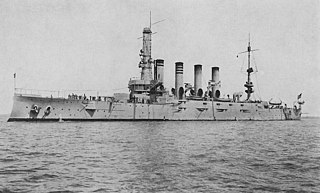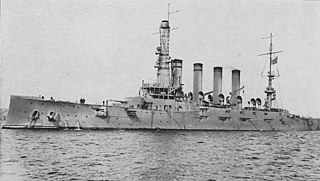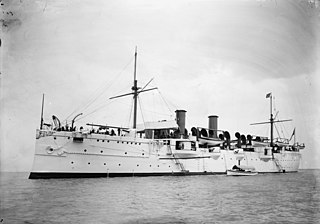
USS Maine (BB-10), the lead ship of her class of pre-dreadnought battleships, was the second ship of the United States Navy to be named in honor of the 23rd state. Maine was laid down in February 1899 at the William Cramp & Sons shipyard in Philadelphia. She was launched in July 1901 and commissioned into the fleet in December 1902. She was armed with a main battery of four 12-inch (305 mm) guns and could steam at a top speed of 18 knots.

USS Wisconsin (BB-9), an Illinois-class pre-dreadnought battleship, was the first ship of the United States Navy to be named for the 30th state. She was the third and final member of her class to be built. Her keel was laid down in February 1897 at the Union Iron Works in San Francisco, and she was launched in November 1898. The completed ship was commissioned into the fleet in February 1901. The ship was armed with a main battery of four 13-inch (330 mm) guns and she had a top speed of 16 knots.

The first USS West Virginia (ACR-5/CA-5), also referred to as "Armored Cruiser No. 5", and later renamed Huntington, was a United States Navy Pennsylvania-class armored cruiser.

The second USS Maryland (ACR-8/CA-8), also referred to as "Armored Cruiser No. 8", and later renamed Frederick, was a United States Navy Pennsylvania-class armored cruiser.

The third USS Charleston (C-22/CA-19) was a United States Navy St. Louis-class protected cruiser. She was launched 23 January 1904 by Newport News Shipbuilding and Dry Dock Co., Newport News, Virginia, sponsored by Miss Helen Whaley Rhett, and commissioned on 17 October 1905, Captain Cameron McRae Winslow in command. She was reclassified CA-19 on 17 July 1920.

USS New York (ACR-2/CA-2) was the second United States Navy armored cruiser so designated; the first was the ill-fated Maine, which was soon redesignated a second-class battleship. Due to the unusually protracted construction of Maine, New York was actually the first armored cruiser to enter U.S. Navy service. The fourth Navy ship to be named in honor of the state of New York, she was later renamed Saratoga and then Rochester. With six 8-inch guns, she was the most heavily armed cruiser in the US Navy when commissioned.

The third USS Albany was a United States Navy protected cruiser of the New Orleans class. She saw service in the Philippine–American War and World War I.

The fifth USS Boston was a protected cruiser and one of the first steel warships of the "New Navy" of the 1880s. In some references she is combined with Atlanta as the Atlanta class, in others as the Boston class.

USS Colorado (ACR-7), also referred to as "Armored Cruiser No. 7", and renamed USS Pueblo (CA-7) in 1916, was a United States Navy Pennsylvania-class armored cruiser. She was the second US Navy ship named Colorado, and the first to be named after the State of Colorado. The first, Colorado, was named for the Colorado River.

The seventh USS Washington (ACR-11/CA-11/IX-39), also referred to as "Armored Cruiser No. 11", and later renamed Seattle and reclassified CA-11 and IX-39, was a United States Navy Tennessee-class armored cruiser. She was laid down on 23 September 1903 at Camden, New Jersey, by the New York Shipbuilding Corporation, launched on 18 March 1905, sponsored by Miss Helen Stewart Wilson, daughter of United States Senator John L. Wilson of Washington state, and commissioned at the Philadelphia Navy Yard on 7 August 1906, Captain James D. Adams in command.

USS Long Beach (CLGN-160/CGN-160/CGN-9) was a nuclear-powered guided missile cruiser in the United States Navy and the world's first nuclear-powered surface combatant. She was the third Navy ship named after the city of Long Beach, California.

USS Montana (ACR-13/CA-13), also referred to as "Armored Cruiser No. 13", later renamed Missoula and reclassified CA-13, was a Tennessee-class armored cruiser of the United States Navy. She was built by the Newport News Drydock & Shipbuilding Co.; her keel was laid down in April 1905, she was launched in December 1906, and she was commissioned in July 1908. The final class of armored cruisers to be built for the US Navy, Montana and her sisters were armed with a main battery of four 10-inch (254 mm) guns, and they were capable of a top speed of 22 knots.

The fourth USS Philadelphia (C-4) was the sixth protected cruiser of the United States Navy. Although designed by the Navy Department, her hull was similar to the preceding British-designed Baltimore, but Philadelphia had a uniform main armament of twelve 6-inch guns.

USS Raleigh (C-8) was a United States Navy protected cruiser of the Cincinnati class, commissioned in 1894 and in periodic service until 1919.

USS Louisville (CL/CA-28), a Northampton-class cruiser, was the third ship of the United States Navy to be named for the city of Louisville, Kentucky. She was active throughout the Pacific War. USS Louisville was the first large warship to be built in a drydock.

USS Kanawha (AO–1) was the lead ship of her class of replenishment oilers of the United States Navy. She was commissioned in 1915 and sunk on 8 April 1943 by Japanese aircraft off Tulagi, Solomon Islands.

USS Hatfield (DD-231/AG-84) was a Clemson-class destroyer in the United States Navy during World War II. She was named for John Hatfield, killed in action 1813. As of 2021, no other ship of the U.S. Navy has been named Hatfield.

The second USS Milwaukee (C-21) was a St. Louis-class protected cruiser in the United States Navy. Entering service in 1906, Milwaukee was deployed to the Pacific Ocean. On 13 January 1917, while aiding a grounded submarine, the cruiser grounded herself. The ship was decommissioned and sold for scrap in 1919.

USS Stoddert (DD-302/AG-18) was a Clemson-class destroyer in the United States Navy following World War I. She was named for Benjamin Stoddert.

USS Gardiners Bay (AVP-39) was a United States Navy seaplane tender in commission from 1945 to 1958 that saw service in the latter stages of World War II and in the Korean War. After her decommissioning, she was transferred to Norway, and she served in the Royal Norwegian Navy as the training ship HNoMS Haakon VII (A537) from 1958 to 1974.





















